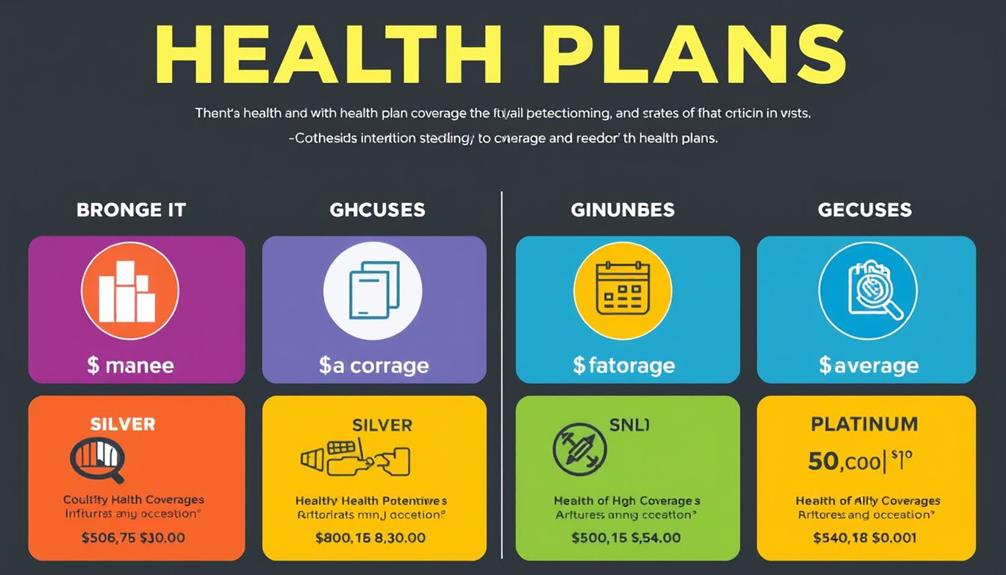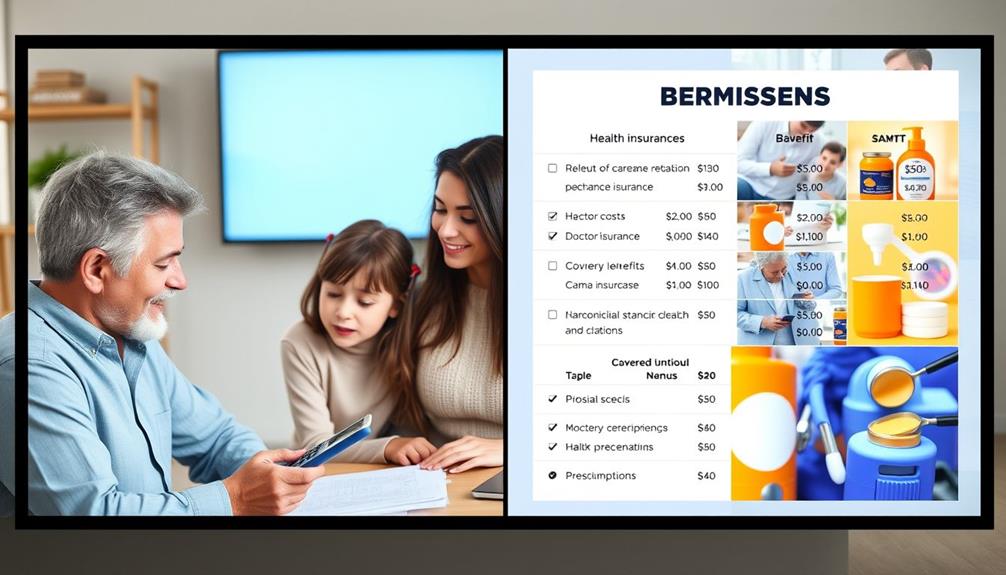Understanding health insurance plans means knowing your options and costs. You're looking at categories like Bronze, Silver, Gold, and Platinum, each with varying premiums and out-of-pocket expenses. Assess your medical needs—frequent visits or major procedures may warrant higher premiums for lower costs later. Explore plan types like HMO, PPO, and EPO, which affect access to providers and flexibility. Check provider networks to avoid unexpected charges. Finally, evaluate benefits and potential savings like tax credits or cost-sharing reductions. By exploring these aspects, you'll make informed choices about your health insurance options that suit your needs and budget.
Key Takeaways
- Evaluate health plan categories (Bronze, Silver, Gold, Platinum) to match your healthcare needs and financial situation effectively.
- Understand key cost components, including monthly premiums, deductibles, and out-of-pocket expenses, to make informed decisions.
- Research provider networks to ensure your preferred doctors are included and minimize unexpected costs during healthcare services.
- Assess financial assistance options like premium tax credits and Medicaid enrollment to reduce overall healthcare expenses.
- Regularly review your healthcare needs and plan benefits to ensure adequate coverage and potential savings during the open enrollment period.
Health Plan Categories

When you're choosing a health insurance plan, understanding the different categories can really help you make an informed decision. Health insurance plans are divided into four main plan categories, known as Metal levels: Bronze, Silver, Gold, and Platinum. Each level reflects the cost-sharing structure between you and your insurance provider, impacting coverage and out-of-pocket costs.
It's important to also consider how these choices can affect your overall financial well-being, similar to how one would assess retirement strategies with cryptocurrency.
Bronze plans usually come with lower premiums but higher out-of-pocket costs for health care services. They're a good fit if you're generally healthy and don't expect to visit the doctor often.
Silver plans strike a balance between premiums and out-of-pocket expenses, often qualifying you for cost-sharing reductions if your income is lower, making them a solid choice for those needing more frequent care.
Gold plans have higher premiums but lower out-of-pocket costs, perfect for individuals or families who anticipate regular health care needs and want predictable expenses.
Finally, Platinum plans offer the highest premiums combined with the lowest out-of-pocket costs, catering to those expecting significant health care usage and who can afford the higher upfront costs.
Understanding these plan categories helps you tailor your choice to fit your healthcare needs and budget.
Understanding Costs

When choosing a health insurance plan, it's essential to understand the costs involved.
You'll need to take into account monthly premiums, deductibles, and various out-of-pocket expenses that can add up quickly.
Additionally, just like evaluating the key factors in choosing a home cleaning service, understanding the total cost of healthcare will help you make a more informed decision about what plan best fits your healthcare needs and budget.
Grasping these elements helps you make a more informed decision about what plan best fits your healthcare needs and budget.
Monthly Premium Overview
Understanding the monthly premium is important for anyone managing health insurance options. The monthly premium is the fixed amount you pay to maintain your health insurance coverage, regardless of whether you use medical services. These premiums can vary widely between different health insurance plans, with Bronze plans typically offering lower premiums and Platinum plans charging higher ones.
Additionally, just like diversifying your retirement portfolio with options like a Gold IRA can mitigate risks, evaluating different health insurance plans can help you find the most cost-effective coverage.
When evaluating a plan, it's essential to take into account the monthly premium alongside other costs, like deductibles and out-of-pocket expenses. This holistic view helps you assess the overall affordability of a health plan. If you qualify for premium tax credits based on your income, you can greatly reduce your monthly premium costs when purchasing insurance through the marketplace.
Moreover, understanding the trade-off between premium costs and out-of-pocket expenses is important. A plan with a lower monthly premium may have higher deductibles or out-of-pocket expenses, impacting your financial situation during healthcare needs.
Consequently, when choosing a health insurance plan, weigh these factors carefully to find a balance that suits both your budget and your healthcare requirements.
Deductible Explained Simply
Maneuvering through the complexities of healthcare costs requires clarity about your deductible, which is the amount you must pay out-of-pocket before your insurance kicks in. For instance, if your deductible is $2,000, you're responsible for the first $2,000 of your medical bills.
Understanding this figure is essential to budgeting your healthcare expenses effectively, especially when considering how lifestyle changes, like mindful eating practices, can influence your overall health and subsequently your medical costs.
Here are some key points to keep in mind about deductibles:
- Deductibles can vary widely between health plans; some may have lower deductibles but higher monthly premiums.
- Once you meet your deductible, your insurance coverage typically starts, covering a percentage of your costs.
- You'll still need to handle copayments and coinsurance for ongoing healthcare services after the deductible is met.
- Many health plans provide certain preventive care services that don't require meeting the deductible first.
Having a clear grasp of your deductible helps you better plan and manage your out-of-pocket expenses throughout the plan year.
Make sure to factor this into your overall healthcare budgeting to avoid surprises when you need care.
Out-of-Pocket Costs Breakdown
After grasping the concept of deductibles, it's time to explore the broader landscape of out-of-pocket costs associated with health insurance. Out-of-pocket costs consist of copayments, coinsurance, and your deductible, along with any additional fees incurred during medical care.
For instance, if your plan has a $2,000 deductible, you'll need to pay that amount before your insurance starts covering costs. Maintaining a healthy lifestyle can also influence your healthcare needs and choices, making it essential to reflect on how your insurance aligns with your wellness goals.
Copayments are fixed fees for specific services—like $30 for a doctor's visit—while coinsurance involves paying a percentage of the bill after meeting your deductible, typically around 20%.
It's important to understand the out-of-pocket maximum, which caps your total expenses for the year. Once you hit this limit, you won't pay more for covered services, regardless of your deductible or copayments.
Understanding these components is significant for budgeting healthcare expenses. They can vary greatly between health insurance plans, directly impacting your overall financial responsibility.
Types of Health Insurance Plans

When choosing a health insurance plan, it's essential to understand the differences between the various types available. Each plan type—like HMO, PPO, EPO, and POS—offers unique provider networks and cost structures that can greatly impact your healthcare experience.
Additionally, just as investors explore different options for maximizing their retirement savings through precious metal investments, understanding the nuances of health insurance can lead to better decision-making. Knowing how these differences affect your access to providers will help you make an informed decision.
Plan Type Differences
Understanding the differences between health insurance plan types is essential for making an informed choice. Each plan type affects your access to healthcare and out-of-pocket costs, so you should consider your healthcare needs and preferences.
Additionally, considering your unique health conditions can help you select the most suitable plan, as some plans offer better coverage for specific treatments, such as those related to gout management strategies.
Here are some key differences among the plan types:
- HMO: Requires members to use a network of providers and get referrals for specialists, which can limit provider choice but promote coordinated care.
- PPO: Offers greater flexibility, allowing you to see any provider without referrals, including out-of-network specialists, though this often leads to higher costs.
- EPO: Covers only in-network services, except in emergencies, eliminating the need for referrals while generally maintaining lower costs than PPOs.
- POS: Combines features of HMO and PPO plans, requiring referrals for specialists but allowing in-network and out-of-network provider choice, with varying costs.
Provider Network Importance
Choosing a health insurance plan involves recognizing the significance of provider networks. These networks consist of healthcare providers who've agreed to provide services at negotiated rates, which can be similar to how division of assets occurs during a divorce—both processes require careful consideration of available options and their implications.
When you choose in-network providers, you typically face lower out-of-pocket costs, which can greatly impact your overall healthcare expenses.
HMO plans require you to stick to a network of doctors and facilities, often needing referrals for specialist services. This structure can limit your flexibility but usually results in lower costs.
On the other hand, PPO plans allow you more freedom in selecting healthcare providers, including out-of-network options, though this comes with higher expenses.
EPO plans offer a middle ground by covering only in-network providers, except in emergencies, helping you manage costs while still maintaining some flexibility.
Finally, POS plans blend HMO and PPO features, requiring referrals for specialists yet allowing for out-of-network access at a higher price.
Understanding these provider network dynamics is essential. By carefully considering how each plan's structure impacts your access to care and costs, you can make a more informed decision that aligns with your healthcare needs.
Quality of Care Resources

Evaluating quality of care resources is essential for making informed decisions about your health insurance plan. By understanding the quality ratings of healthcare providers and hospitals, you can effectively compare care options that meet your needs.
Utilizing state and national databases will provide you with insights into the accreditation status of facilities, indicating their commitment to care standards. Additionally, being aware of the impact of emotional well-being, much like the effects of narcissistic abuse on relationships, can influence your healthcare decisions.
Consider these key resources for your evaluation:
- Quality Ratings: Compare ratings to gauge overall performance.
- Accreditation Status: Check if facilities meet recognized care standards.
- Patient Reviews: Read experiences from other patients to understand care quality.
- In-Network Options: Use tools to find providers covered by your plan.
These resources help you assess the quality of care, making your plan selection process smoother.
Finding Savings and Coverage

When it comes to finding savings and coverage in health insurance plans, many people overlook the importance of thorough research. Start by using quick tools available on HealthCare.gov to check your eligibility for premium tax credits that can greatly reduce your monthly insurance costs.
If you're an eligible individual, don't forget about cost-sharing reductions, which can lower your out-of-pocket expenses, influencing your plan selection. Additionally, consider how wellness practices, such as yoga for back pain management, can play a role in your overall health, potentially leading to lower medical expenses in the long run.
Review the summary of benefits and plan brochures carefully to grasp key coverage details. This guarantees you understand what services are included and helps avoid unexpected costs later.
Utilize provider directories and drug lists to assess the adequacy of coverage, confirming that your preferred doctors and necessary medications are included in the plan.
Remember to regularly reassess your health care needs and costs. Conducting annual reviews of your existing plans can lead to better coverage options and potential savings.
Assessing Medical Needs

Evaluating your medical needs is essential for selecting the right health insurance plan. Start by determining how often you visit the doctor, including routine check-ups and any specialist consultations. This will give you insights into your healthcare utilization patterns.
Next, consider any upcoming major procedures or treatments that could greatly impact your healthcare costs. Don't forget to review your current medication requirements; check for available generic options to minimize your out-of-pocket expenses.
Additionally, take into account the health needs of your entire family. This will influence the overall coverage required and associated costs.
Here are some key factors to keep in mind:
- Frequency of doctor visits and specialist consultations
- Upcoming major medical procedures or treatments
- Current medication needs and cost options
- Family health considerations and coverage requirements
Provider Networks

Maneuvering the landscape of provider networks is vital for finding a health insurance plan that aligns with your needs. Provider networks consist of contracted medical providers and facilities, which typically offer lower costs due to negotiated rates.
When you choose in-network providers, you'll benefit from reduced out-of-pocket expenses compared to out-of-network providers, who may charge higher fees or not be covered at all.
Plans like Health Maintenance Organizations (HMOs) and Preferred Provider Organizations (PPOs) have distinct rules regarding access to care. HMOs often require referrals for specialist visits, while PPOs provide more flexibility, allowing direct access without needing referrals.
It's important to check the provider directory of your selected health plan to verify your preferred doctors and specialists are included. This can help you avoid unexpected costs.
Understanding the differences in provider networks can greatly impact your healthcare expenses. Evaluating plan options carefully can lead to better access to care and make managing costs more manageable.
Prioritize your needs and preferences while considering how provider networks fit into your overall health plan decision-making process.
Comparing Benefits and Premiums

After understanding provider networks, the next step is to compare benefits and premiums across different health insurance plans. You'll want to evaluate how each plan aligns with your health requirements while reflecting on both the premiums and out-of-pocket costs.
Here are some key factors to take into account:
- Covered services: Confirm essential services, like mental health care and emergency services, are included in the plan.
- Premiums vs. out-of-pocket costs: Higher premium plans often have lower out-of-pocket costs, which can be beneficial if you need frequent medical care.
- Coverage limits: Review the Summary of Benefits to understand any limitations or exclusions on services.
- Customer service: Don't hesitate to reach out for clarifications. A responsive customer service team can help you navigate plan differences effectively.
For instance, a Silver plan might strike a balance between moderate premiums and out-of-pocket expenses, while a Bronze plan offers lower premiums at the cost of higher out-of-pocket costs.
Taking the time to compare these elements will empower you to choose the best plan for your needs.
Navigating the Health Insurance Marketplace

Maneuvering through the Health Insurance Marketplace can feel overwhelming, but breaking it down into manageable steps makes it easier. Start by understanding the different types of health plans available, such as Health Maintenance Organizations (HMOs), which often require you to choose a primary care doctor.
During open enrollment, typically from November 1 to January 15, you can compare various Marketplace plans to find the best health insurance for your needs.
You'll encounter four metal categories: Bronze, Silver, Gold, and Platinum. These indicate how costs are shared between you and the insurer. Bronze plans have lower premiums but higher out-of-pocket costs, while Platinum plans offer the opposite.
Remember, all Marketplace plans must include the ACA's essential health benefits, which cover crucial health care services like preventive care and hospitalization.
If you qualify, consider applying for a premium tax credit to help lower your monthly costs. Don't forget that Medicaid enrollment is open year-round, providing additional options.
Frequently Asked Questions
What Are 3 Things You Need to Consider When Choosing Your Health Insurance?
When choosing your health insurance, consider your healthcare needs, total costs including premiums and deductibles, and guarantee your preferred doctors are in-network. These factors help you find a plan that fits your lifestyle and budget.
What Is the Best Way for an Individual to Choose a Health Insurance Plan?
To choose the best health insurance plan, assess your healthcare needs, compare costs, and check provider networks. Understanding different plan types will help you make an informed decision that fits your situation and budget.
What Are the 4 Most Common Health Insurance Plans?
When it comes to health insurance, you've got a few options. The four most common plans are HMO, PPO, EPO, and POS. Each offers different coverage and costs, so you'll want to weigh them carefully.
What Factors Should Be Considered Before Enrolling in a Health Insurance Plan?
Before enrolling in a health insurance plan, you should consider your healthcare needs, preferred doctors, total costs, the type of plan, and enrollment deadlines. These factors'll help you make an informed decision for your coverage.
Conclusion
Managing health insurance doesn't have to be overwhelming. By understanding plan categories, evaluating your medical needs, and comparing costs, you can make informed choices that suit your lifestyle. Consider provider networks, assess benefits, and seek out savings to maximize your coverage. Remember, it's about finding a plan that fits your health requirements and your budget. With the right approach, you can secure the care you need while ensuring peace of mind for your financial future.










